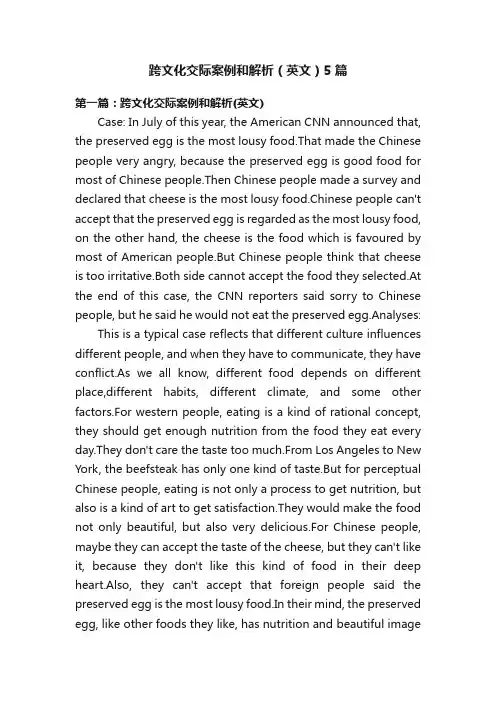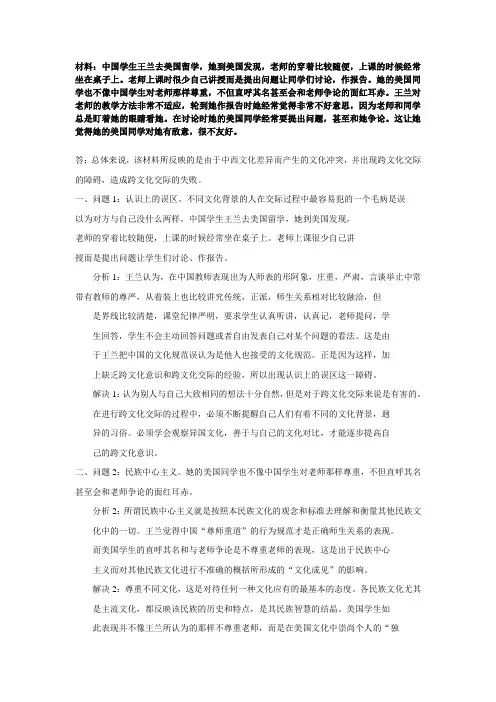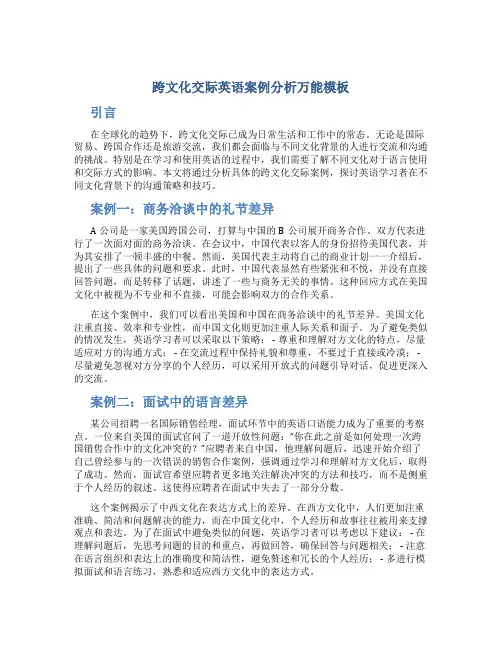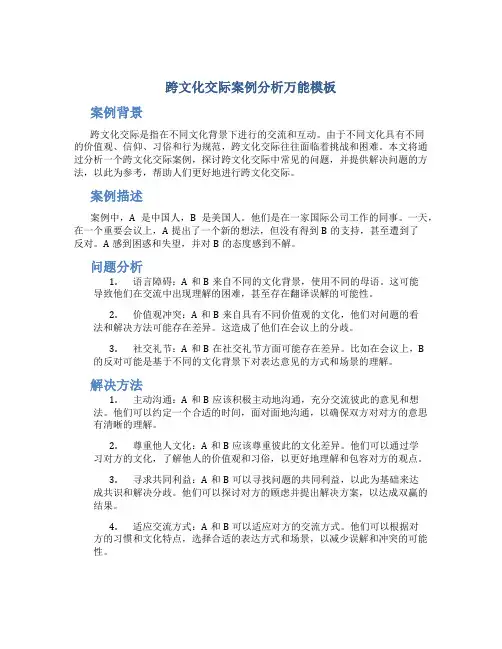跨文化交际案例分析
跨文化交际案例和解析(英文)5篇

跨文化交际案例和解析(英文)5篇第一篇:跨文化交际案例和解析(英文)Case: In July of this year, the American CNN announced that, the preserved egg is the most lousy food.That made the Chinese people very angry, because the preserved egg is good food for most of Chinese people.Then Chinese people made a survey and declared that cheese is the most lousy food.Chinese people can't accept that the preserved egg is regarded as the most lousy food, on the other hand, the cheese is the food which is favoured by most of American people.But Chinese people think that cheese is too irritative.Both side cannot accept the food they selected.At the end of this case, the CNN reporters said sorry to Chinese people, but he said he would not eat the preserved egg.Analyses: This is a typical case reflects that different culture influences different people, and when they have to communicate, they have conflict.As we all know, different food depends on different place,different habits, different climate, and some other factors.For western people, eating is a kind of rational concept, they should get enough nutrition from the food they eat every day.They don't care the taste too much.From Los Angeles to New York, the beefsteak has only one kind of taste.But for perceptual Chinese people, eating is not only a process to get nutrition, but also is a kind of art to get satisfaction.They would make the food not only beautiful, but also very delicious.For Chinese people, maybe they can accept the taste of the cheese, but they can't like it, because they don't like this kind of food in their deep heart.Also, they can't accept that foreign people said the preserved egg is the most lousy food.In their mind, the preserved egg, like other foods they like, has nutrition and beautiful imagetogether.For western people, the cheese, is also this kind of good food for them.So, this case happened in their communications.This conflict showed that, different countries have different culture.We should try to accept these differences, do our favours.By susan第二篇:跨文化交际英文Analysis of Deferent Views on “Filial Piety” Betwee n China and American from Movie GuashaAbstract: “While one’s parents are alive, one should not travel to distant places.” “The gentleman works hard on the basic principles, thereafter comes morality;filial piety is the basic principle of a human being.” T hese are our Chinese traditional filial piety.But are these standards or rules suitable for every nation? The movie Guasha shows us many about the differences of filial piety between China and American.There are many misunderstanding and coincidence in this movie and those are the cause of the circuitous of the characters’ fate.All of these are rooted in the cultural differences between China and American.In this assay, I made the differences of filial piety as the point of entry to analyze the reason why the differences come and their similarity.Key words: Guasha, the culture in china and America, piety, filial piety, object The movie Guasha tells a story that a Chinese couple who lived in American for 8 years took the hero’s father in American after they t hink they had realized their American dream.But a few days later, their son got ill;the old father used Guasha to treat the little boy for he didn’t know how to read English.The bruises were noticed by the child welfare bureau, and all the rough broke out after that.Finally, they had a universal satisfactory ending.The end of the story is to the satisfaction of all, but a variety of cultural conflict is theapparent.What we see is the initial irreconcilable to accept, understand.Many people will think that Chinese and Western have cultural differences, I think so, but I also think that behind these differences, there are many similarities.The following, I will be on the film to talk something about filial piety plot makes concrete analysis, and explore how cultural differences reflected in the filial piety? Why is it? What are the similarities?But before that, we will first do a general understanding of filial piety.In the ancient clan and tribal society, meaning of “filial piety” is very wide.It refers to t he family of the elder respect, love, support and sacrifice.With the family as the basic unit of society and social development in a long time, “filial piety” changes from the family elder respect to parental care, and become an important ethical rule to do with family relations.Today, “filial piety” to living gets more attention.We often say that the parents contribute to our upbringing, so we will repay the parents.While in the west, has no concept of “filial piety”.The Western belief in God, that God has given human life.So in the western culture, the concept of “filial piety” is corresponding to “piety”.” Filial piety “ is also derived from “piety”.Piety in the ancient Greek dictionary definition is: 1, sacred, permitted by the laws of God, to God;2, non God prohibited by law, human beings can enjoy.In the two concepts, actually we can see, in the West or in China, for the one who supposed to give us life, raising us people have a kind of “filial piety”, just for different objects.Situation one: acquiesce and even publicly agree the old father smoking in the house There are two such scenes: 1, at the table, the old father smoking, Denis sat next to Grandpa.Janine saw father smoking, showed her disgust on her face, and then to open the window.XuDatong saw this scene, said: “Janine, why?” Full of condemnation, for fear that his father felt reject by his families.2, the house was dark.The old father who was smoking at home saw the couple suddenly returned home looked panic, hiding the cigarette behind.He knew the daughter-in-law doesn't like him smoking in the house.In order to avoid his son and the daughter-in-law’s quarrel, he decided to put out the cigarette.At this time, Janine became clever.In order to make obedient husband don’t feel disgusted, she said: “Dad, go ahead, I don't mind.”In the two acts, both husband and wife knew smoking is harmful to health, but they did not prevent him from it.The reason is the filial piety.Since ancient times, Chinese are taught to obey.We cannot be a disobedient child.Even if the parents are wrong, we are not allowed to contradict them.That case in America, however, children will stop their parents since smoking is harmful to health.this is ”filial piety“ in the eyes of Americans.What lead the United States look the same thing quite different from Chinese? Personally I think that we should go back to the objects both sides to do ”filial piety“.As we said earlier, Chinese parents act as life giver and caregivers, while Americans believe God give them life whereas their parents are just pull them out.Therefore, Chinese parents and children are hierarchical, that is the so-called ”respect for seniority“.And in America, almost people are Christian.Parents and children are in the same class.They tend to be friends, just pointed out the fault and regardless of other things such as against.Scene two: taking old father in America to live togetherIn china, Datong is absolutely a dutiful son because it’s admirable to make parents live with their son and daughters.I guess no one in China would deny that.But in America, suchbehavior just can't be understood.Why the old father did not to live in his home, but in his son’s? Americans are puzzled, because in American, parents and children do not live together.Even when parents visit children, they have to make an appointment few weeks or even a few months before.This behavior in Chinese eyes seems incredible.They think that the relationship between American parents and children is too distant.In a word, both sides look at each other and feel nothing is right.Why? They have different ideas.Chinese like four generations under one roof, family happiness;while the Americans pay attention to individual personality, advocate individualism and independence of thought.And why the concept is different? We start from the filial piety and piety as well.Earlier we said that both China and the US have ”filial piety“, while the object is different.Chinese is more willing to live with parents, to do filial piety.The US is not with their parents who pull them into this world, because in their eyes, the role of parents is actually more like China brothers and sisters and it’s God who give their lives and souls.In Chinese, even if one large ancient family which people live together, in fact, can be divided into several small courtyards, deal with family affairs separately except some important issues.These partitional rules are more clear the modern life.Have you ever seen brothers and sisters live together? Perhaps no.Therefore, the Americans and their parents(like brothers and sisters)living in different roof is not surprising.Scene three: the understanding of “hitting you is for your own good”When Xu Datong hit Denis, Quinlan appeared shocked and uneasy.Denis did not want to sit by the side of his father at table for his father beat him.Grandpa told him that his father hit himfor his own good.People in China and America hold different positions to the same thing.In Chinese, to spare the rod was, traditionally, to spoil the child.The father to beat his son is good for son, son should not hold grudges, and they should obey the discipline, or it’s impiety;Americans think this behavior is abuse.It’s the appearance of not respecting the human rights.First, their laws don't allow this behavior.All are equal before the law.It’s illegal for the fathers to hit sons.It is a violation of human rights and a violation of the law.Second I think it is more important that Americans, from the bottom of their heart, think their parents and themselves are equal.Deep in their hea rts, the one who give them souls and lives isn’t parents, but the God.Though China has the law that everyone is equal, but the parents’ hit on children is called they are educating the children, and no one would charge their parents.Because Chinese parents are as holy American’s God, play as the life and soul giver.So there are grades between parents and children in China.They never think that they themselves and their parents are equal.All of this is according to the different object of ”filial piety“.Conc lusionIn cross-cultural communication, collision and conflict of culture can be seen everywhere.What the movie ”Guasha“ shows is only the tip of the iceberg.All differences originate in the differences in history, conception, belief, value.But the ”filial piety“ differences in Guasha are root in the different philosophical thinking about the sources of human.China as an atheist state(at least most people do), both the body and soul are given by parents.So parents have the sacred place in the hearts of their children and the place is inviolable.So in these situations above, Chinese will havedifferent attitudes and practices with foreigners.And USA, as a Christian country, affected by the Bible story of Adam and Eve, people in this country believe that man is created by God, they believe God gave the soul to the flesh, and God is their Lord who makes them able to survive and multiply.The loftiness of his position is no less than Chinese parents.That is the reason why the relationships in Americans and their parents are not as tight as Chinese do.As for the “filial piety”, China and the US have something in common.Although their concepts are different, the meaning is the same.God is to American what parents are to Chinese.all have the same emotional ties and treatment.That is to say, both have ”filial piety“, but American ”filial piety“ is for God, as we know, the “piety”.It is because of the different objects that there are so many cultural conflicts about ”filial piety” in Guasha, and then the perplexing “filial piety” cultural conflict in the whole society.第三篇:跨文化交际案例分析跨文化交际案例分析案例背景:在泰国,和泰国朋友在网上聊天时,他们有时候会发来“555”,本来是说到开心的时候,为什么要用这几个数字呢?在中国聊天时555表示哭的声音。
跨文化交际案例分析题及答案

跨文化交际案例分析题及答案案例描述在跨国公司A的一个国际会议上,来自不同国家的员工们需要共同讨论一个重要项目。
会议进行了几天,但是却一直没有取得明确的进展。
不同国家的员工语言文化差异导致了沟通障碍,讨论过程中出现了许多误解和纠纷。
公司高层深感困惑,希望找到解决这个问题的方法。
障碍分析1. 语言障碍跨国公司A的员工来自不同的国家,他们使用的是各自母语进行交流。
除了英语是共同的工作语言外,其他国别的员工使用的语言差异较大。
这种语言差异导致了语言表达的不准确和理解的模糊,使得员工们无法正常交流和理解对方。
2. 文化差异不同国家的员工具有不同的文化背景和价值观念,这导致了他们在讨论过程中产生了误解和冲突。
文化差异可以涉及到对时间观念、权力关系、政治正确性和个人自由等方面的不同理解,这些差异会影响到他们的决策方式和工作方式,导致合作的困难。
解决方案1. 提供语言支持和培训跨文化交际的第一个挑战是语言障碍。
为了解决这个问题,公司可以提供语言支持和培训,以帮助员工们提高英语或共同工作语言的能力。
这可通过组织语言培训课程,雇佣专业翻译人员或提供翻译工具等方式实现。
提供语言支持和培训可以降低语言障碍,提高员工之间的沟通效率。
2. 开展跨文化培训除了语言障碍外,文化差异也是讨论中的一个重要问题。
公司可以组织跨文化培训,帮助员工了解不同文化之间的差异,并教授他们如何在跨文化环境中进行有效的沟通和合作。
该培训可以包括介绍不同文化的价值观、信念和行为准则,以及跨文化冲突解决的技巧和策略。
通过开展跨文化培训,可以提高员工对文化差异的认识和理解,促进跨文化交际的顺利进行。
3. 引入跨文化中介人为了解决跨文化交际中的难题,公司可以考虑引入跨文化中介人。
跨文化中介人是具有跨文化交际经验和能力的人员,他们可以在员工之间进行翻译和解释,协助双方理解并解决可能出现的误解和冲突。
跨文化中介人的介入可以减少员工之间的摩擦,促进合作和理解。
跨文化交际相关案例分析

材料:中国学生王兰去美国留学,她到美国发现,老师的穿着比较随便,上课的时候经常坐在桌子上。
老师上课时很少自己讲授而是提出问题让同学们讨论,作报告。
她的美国同学也不像中国学生对老师那样尊重,不但直呼其名甚至会和老师争论的面红耳赤。
王兰对老师的教学方法非常不适应,轮到她作报告时她经常觉得非常不好意思,因为老师和同学总是盯着她的眼睛看她。
在讨论时她的美国同学经常要提出问题,甚至和她争论。
这让她觉得她的美国同学对她有敌意,很不友好。
答:总体来说,该材料所反映的是由于中西文化差异而产生的文化冲突,并出现跨文化交际的障碍,造成跨文化交际的失败。
一、问题1:认识上的误区。
不同文化背景的人在交际过程中最容易犯的一个毛病是误以为对方与自己没什么两样。
中国学生王兰去美国留学,她到美国发现,老师的穿着比较随便,上课的时候经常坐在桌子上。
老师上课很少自己讲授而是提出问题让学生们讨论、作报告。
分析1:王兰认为,在中国教师表现出为人师表的形阿象,庄重,严肃,言谈举止中常带有教师的尊严,从着装上也比较讲究传统,正派,师生关系相对比较融洽,但是界线比较清楚,课堂纪律严明,要求学生认真听讲,认真记,老师提问,学生回答,学生不会主动回答问题或者自由发表自己对某个问题的看法。
这是由于王兰把中国的文化规范误认为是他人也接受的文化规范。
正是因为这样,加上缺乏跨文化意识和跨文化交际的经验,所以出现认识上的误区这一障碍。
解决1:认为别人与自己大致相同的想法十分自然,但是对于跨文化交际来说是有害的。
在进行跨文化交际的过程中,必须不断提醒自己人们有着不同的文化背景,迥异的习俗。
必须学会观察异国文化,善于与自己的文化对比,才能逐步提高自己的跨文化意识。
二、问题2:民族中心主义。
她的美国同学也不像中国学生对老师那样尊重,不但直呼其名甚至会和老师争论的面红耳赤。
分析2:所谓民族中心主义就是按照本民族文化的观念和标准去理解和衡量其他民族文化中的一切。
王兰觉得中国“尊师重道”的行为规范才是正确师生关系的表现。
跨文化交际案例分析

Case 1: She Has Three HandsIn the following scenario, a Chinese doctor, a patient and a physiotherapist interact.A female neurologist from Beijing was working on a research project in a Toronto hospital. She shared a small office with a young Canadian male from a large family, who loved peanut butter. He was so fond of peanut butter that he kept a jar in the office. One day he came into the office and exclaimed, “Who took my peanut butter?” But the Chinese woman immediately felt accused. After all, there were only two of them in the office.She was deeply distressed, but true to her learned cultural behavior of never showing anger in public, she said nothing. Later that day she was working in a room where the physiotherapist was treating a patient who suffered paralysis of his legs and arms from a motorcycle accident. The physiotherapist moved one of the patient’s legs in a way that caused him pain.“Ouch!” he cried.“Oh, I didn’t do that,” said the physiotherapist. “It was that doctor over there,” and he pointed to the Chinese woman.“How could she have done it since she’s on the other side of the room?” the patient pointed out.“Ah, she has three hands.” the physiotherapist replied.At these words the Chinese doctor became even more upset. She was so disturbed that she behaved in a way uncharacteristic of her culture. She waited until the patient had gone, and then said to the physiotherapist, “I’m very upset by what you said.” The physiotherapist was taken aback. “What had I said?”“You said I had three hands,” the Chinese doctor finally choked. “You think I took the peanut butter.”Answer the following questions:1.How do you understand the phrase “to have three hands”? (3分)2.What caused their communication conflicts?(7分)Case 1:This case can reflect the different communication styles between Chinese and Canadians. In western cultures, communication is the means of transmitting ideas. Western people usually communicate directly with each other. That is why the Canadian in this case says what is in his mind directly in front of the Chinese woman without hiding anything. While Chinese culture stresses harmony and emphasizes the relationships between the communicators. Chinese people view communication as a process where all parties are searching to develop and maintain a social relationship. So the Chinese woman in this case tries not to argue with the Canadian face to face to keep the“harmonious relationship”between them.Case 2: Left in the ColdKatherine came to Beijing in 1998 and found a job as an English teacher in a foreign language institute. Soon after her classes began she found that her students showed no interest in her teaching style. Quite a few of them avoided attending her class. She was feeling quite upset and discouraged so she decided to ask the Director, Prof. Wang for help. Prof. Wang reviewed his timetable and suggested they meet at ten o’clock on Thursday morning. When Thursday came, Katherine arrived at Prof. Wang’s office at the exactly ten o’clock finding him talking with another teacher in Chinese. Seeing that she had come, Prof. Wang smiled and gestured her to sit down. Katherine sat down and the professor excused himself and continued to talk with the other teacher. After five minutes, he finished his conversation, and apologized to Katherine, and began to focus his attention on her situation. Prof. Wang showed great concern and asked her what the problem was. Just as she was discussing her problem, another Chinese teacher interrupted, with a form that required the Director’s signature. The Director smiled, apologized to Katherine again, and turned to talk with the Chinese teacher in Chinese. Katherine became impatient, and wondered why their discussion should be interrupted since she had made an appointment. Also, she was upset and frustrated that they continued to speak Chinese in front of her. Although their talk continued, she was apparently unhappy about what had happened.Answer the following questions:1.How would you explain the Director’s behavior toward Kathrine?(5分)2.How would you make the Director understand why Katherine felt frustrated and angry? (5分)Case 2:CommentThis is a typical cultural clash between Chinese and Westerners. There is a great difference in the concept of appointment and its behavior pattern in different cultures. To Americans, an appointment is a confirmation to meet at a precise time. If an appointment is scheduled, both parties should respect the appointment time. For example, if a professor makes an appointment with a student at a certain time, it should not be interrupted by other things or people. In addition, Westerners are good timekeepers; they adhere strictly to schedules. However, Chinese view appointments in a more flexible manner. They are more casual about commitments. This difference in attitudes toward appointment was the root of Katherine’s unhappiness. Since the Director made an ten a’clock appointment, he should have tried to avoid any interruption. However, when Katherine arrived on time, the Director was still talking with another teacher. When their meeting finally began, it was interrupted again. There is no wonder Katherine became frustrated and angry.Case 3: Personal SpaceMark had recently moved from Denmark to Sydney to work as a salesperson for a large Australian company. After three weeks, he was invited to join a local club. During the first few weeks at the club, Mark would either stand in the corner talking with someone or sit on a sofa listening to other people talk and chat. As time went by, he came to know most of the club members and seemed to enjoy talking with them. One day, at an evening party one of the female members approached him. Mark immediately showed his interest by talking about the atmosphere of the party. At first, the conversation between them seemed to go quite smoothly, but as it progressed the lady seemed to step further and further away from Mark as he had been gradually moving closer to her. The lady obviously seemed uncomfortable. As Mark was about to ask her questions regarding Australian social customs, another man standing nearby directed a glance toward the lady. She excused herself and went to talk with that man, leaving Mark standing alone and wondering why their conversation had come to such a sudden stop.Answer the following question1. Why did that woman suddenly stop talking with Mark and turned to another man? (10分)Case 3:This is a typical case of misunderstanding caused by different perceptions abut body distance.There is a lot of evidence to show that body distance varies with different people, different circumstances, and different cultures. In Denmark, at a formal event, the intimate space is usually between 20 to 30 centimeters; while in Australia such an occasion requires a body distance of 40 to 50 centimeters. Therefore when a Dane talks with an Australian, the problem arises: the Dane is accustomed to a close distance while the Australian is comfortable with a great distance.In this case, Mark, by trying to establish his normal intimate space, infringed on the Australian lady’s space. Because of this, she felt somewhat threatened and lost her sense of comfort. At that moment, the nearby man offered her the opportunity to excuse herself from Mark. If Mark had had some knowledge about the expected personal space for Australians, the encounter might have been totally different.Case 4Li Ming, a male Chinese graduate student, studied in the United States. He shared a room with his American classmate Tony in a residence hall. At the very beginning, Li Ming found it easy and enjoyable to get along with Tony, for he was an open-minded person and sometimes he could give Li Ming quite a lot of helpful advice. But later,Li Ming felt it really hard to do the real effective communication. For example:One day Tony went into the bathroom and completely shaved his head. Li Ming easily discovered this fact when he himself visited the bathroom and saw the hair everywhere. He returned to his room and said to Tony, “You’ve shaved your head.” Tony replied, “Yeah, I did.”Li Ming waited a while, then said, I discovered you’d shaved your head when I went into the bathroom and saw the hair. “Yeah.” Tony confirmed. Li Ming was at a loss. He believed he had communicated in the strongest possible language his wish that the American would clean up the mess he’d made in the bathroom. But Li Ming was very much disappointed at his roommate Tony!Later he discussed the surprising episode with some Chinese friends who told him, “Listen, with Americans you actually have to say: Clean up the bathroom!” Li Ming believed his message had been very clear. However, he was relying on the context of the communication for the message to be understood: hair was all over the bathroom, and his roommate now was bare-headed.Questions:1. Why do you think the American student Tony failed to understand what his Chinese roommate Li Ming had wanted to say?2. Suppose the main characters in the story are two Chinese studentsor two American students, in what way will they deal with the matter?Case 7 (P30)Case analysis: Cultural differences decide the two students are going to communicate in different ways. 案例分析:文化差异决定这两个学生要沟通的方式不同。
跨文化交际英语案例分析万能模板

跨文化交际英语案例分析万能模板引言在全球化的趋势下,跨文化交际已成为日常生活和工作中的常态。
无论是国际贸易、跨国合作还是旅游交流,我们都会面临与不同文化背景的人进行交流和沟通的挑战。
特别是在学习和使用英语的过程中,我们需要了解不同文化对于语言使用和交际方式的影响。
本文将通过分析具体的跨文化交际案例,探讨英语学习者在不同文化背景下的沟通策略和技巧。
案例一:商务洽谈中的礼节差异A公司是一家美国跨国公司,打算与中国的B公司展开商务合作。
双方代表进行了一次面对面的商务洽谈。
在会议中,中国代表以客人的身份招待美国代表,并为其安排了一顿丰盛的中餐。
然而,美国代表主动将自己的商业计划一一介绍后,提出了一些具体的问题和要求。
此时,中国代表显然有些紧张和不悦,并没有直接回答问题,而是转移了话题,讲述了一些与商务无关的事情。
这种回应方式在美国文化中被视为不专业和不直接,可能会影响双方的合作关系。
在这个案例中,我们可以看出美国和中国在商务洽谈中的礼节差异。
美国文化注重直接、效率和专业性,而中国文化则更加注重人际关系和面子。
为了避免类似的情况发生,英语学习者可以采取以下策略: - 尊重和理解对方文化的特点,尽量适应对方的沟通方式; - 在交流过程中保持礼貌和尊重,不要过于直接或冷漠; - 尽量避免忽视对方分享的个人经历,可以采用开放式的问题引导对话,促进更深入的交流。
案例二:面试中的语言差异某公司招聘一名国际销售经理,面试环节中的英语口语能力成为了重要的考察点。
一位来自美国的面试官问了一道开放性问题:“你在此之前是如何处理一次跨国销售合作中的文化冲突的?”应聘者来自中国,他理解问题后,迅速开始介绍了自己曾经参与的一次错误的销售合作案例,强调通过学习和理解对方文化后,取得了成功。
然而,面试官希望应聘者更多地关注解决冲突的方法和技巧,而不是侧重于个人经历的叙述。
这使得应聘者在面试中失去了一部分分数。
这个案例揭示了中西文化在表达方式上的差异。
跨文化交际案例分析万能模板

跨文化交际案例分析万能模板案例背景跨文化交际是指在不同文化背景下进行的交流和互动。
由于不同文化具有不同的价值观、信仰、习俗和行为规范,跨文化交际往往面临着挑战和困难。
本文将通过分析一个跨文化交际案例,探讨跨文化交际中常见的问题,并提供解决问题的方法,以此为参考,帮助人们更好地进行跨文化交际。
案例描述案例中,A是中国人,B是美国人。
他们是在一家国际公司工作的同事。
一天,在一个重要会议上,A提出了一个新的想法,但没有得到B的支持,甚至遭到了反对。
A感到困惑和失望,并对B的态度感到不解。
问题分析1.语言障碍:A和B来自不同的文化背景,使用不同的母语。
这可能导致他们在交流中出现理解的困难,甚至存在翻译误解的可能性。
2.价值观冲突:A和B来自具有不同价值观的文化,他们对问题的看法和解决方法可能存在差异。
这造成了他们在会议上的分歧。
3.社交礼节:A和B在社交礼节方面可能存在差异。
比如在会议上,B的反对可能是基于不同的文化背景下对表达意见的方式和场景的理解。
解决方法1.主动沟通:A和B应该积极主动地沟通,充分交流彼此的意见和想法。
他们可以约定一个合适的时间,面对面地沟通,以确保双方对对方的意思有清晰的理解。
2.尊重他人文化:A和B应该尊重彼此的文化差异。
他们可以通过学习对方的文化,了解他人的价值观和习俗,以更好地理解和包容对方的观点。
3.寻求共同利益:A和B可以寻找问题的共同利益,以此为基础来达成共识和解决分歧。
他们可以探讨对方的顾虑并提出解决方案,以达成双赢的结果。
4.适应交流方式:A和B可以适应对方的交流方式。
他们可以根据对方的习惯和文化特点,选择合适的表达方式和场景,以减少误解和冲突的可能性。
结论跨文化交际虽然存在挑战和困难,但通过主动沟通、尊重他人文化、寻求共同利益和适应交流方式等方式,我们可以更好地解决问题,建立跨文化交际的良好关系。
希望通过这个万能模板,能帮助更多人在跨文化交际中更加成功和顺利。
跨文化交际案例及分析(精选5篇)
跨文化交际案例及分析(精选5篇)跨文化交际案例及分析范文第1篇[关键词]跨文化外语教学案例分析大同学跨文化交际本领一、跨文化英语教学现状分析就我国的外语教学现状而言,高一虹(2023:28)指出,现有的跨文化交际本领培育模式都有肯定局限。
行为中心的培育模式,只关注交际行为本身和交际结果,执着于实在目标,但在我们一般性的大学教育中,很难确定同学将来可能与之打交道的目的文化,因此也很难像对特定出国人员进行培训那样对同学实施有较强针对性的训练;学问中心模式,则集中于认知层面,重要向同学灌输有关文化学问,但难以让同学产生切身体验,而且还不适用于处理文化的多样性和动态性,传授文化学问简单变成“定型”(stereotype),反而不利于跨文化交际本领向较高层次进展。
另外,我们的教学大纲设计和教学实践往往缺乏充足的开放性,没有给同学较多面对问题和独立解决问题的机会。
因此在跨文化外语教学中,需要依据跨文化交际本领框架,提高同学使用语言的正确性的同时还要帮忙其提高言语行为的得体性。
在近年来对跨文化交际本领框架的浩繁讨论中,笔者认为杨盈、庄恩平(2023)提出的由全球意识、文化调适、文化学问和交际实践四大本领系统构成的外语教学跨文化交际本领框架,符合教学大纲和教学实践的要求,具较强可行性。
二、案例分析在跨文化英语教学中的作用目前跨文化英语教学普遍采纳的方法重要包括背景学问导入、文化内涵探究、案例分析、角色扮演及情景仿照、实例搜索等。
案例分析教学中将不同文化背景的语言特色、风土人情、历史事件和现实冲突等素材呈现于同学面前,是跨文化学问、意识、思维和交际本领的综合训练过程,能帮忙同学达到学习外语语言技能与培育跨文化交际本领有机结合的目的。
在谈到案例教学法时,陈建平(2023)强调:“案例是为适应特定的教学目的而编写的”,教学过程重要是“同学之间的讨论和辩论”,教学目的重要是“培育同学的本领”。
上述特点,使案例教学能很好适用于跨文化外语教学,它对培育本领的重视大过取得学问,成为语言文化学问向跨文化本领变化的有效途径。
跨文化交际案例分析
案例三:非语言交际行为的误解
情况描述
在一次国际晚宴中, 一位美国客人和一位 日本客人之间的社交 礼仪产生了差异。美 国客人习惯于直接、 热情的礼仪,而日本 客人则更注重谦虚和 尊重。这导致双方在 晚宴中的互动出现了 尴尬和误解
案例三:非语言交际行为的误解
问题分析
这个案例中的问题主要是由社交礼仪的差异引起的。美 国客人和日本客人的社交礼仪存在明显差异,这种差异 可能导致双方在互动中产生误解和尴尬
案例三:非语言交际行为的误解
解决方案
为了解决这个问题,首先需要认识到这种社 交礼仪的差异,并尊重彼此的礼仪习惯。美 国客人可以尝试更理解日本客人的谦虚和尊 重,而日本客人也可以尽可能适应美国客人 的直接和热情。双方可以通过了解彼此的社 交礼仪,找到一个共同的解决方案,以达到 和谐的互动
PART 4
案例五:食物与文化的关系
4
案例五:食物与文化的关系
情况描述
在一个国际家庭聚会 中,来自不同国家的 亲戚们在一起共享美 食。然而,由于食物 与文化的关系不同, 一些食物在某些国家 是受欢迎的,而在其 他国家却被视为禁忌 。这导致了一些尴尬 和误解
案例五:食物与文化的关系
问题分析
这个案例中的问题主要是由食物与文化的关系引起的。 来自不同国家的亲戚们对食物的认知和文化背景存在差 异,这种差异可能导致在共享美食时产生尴尬和误解
案例一:语言与文化差异的处理
解决方案
为了解决这个问题,首先需要认识到这种语 言与文化差异的存在,并尊重彼此的交际风 格。英国员工可以尝试更能明确表达 自己的意见。此外,双方还可以通过提高彼 此的语言能力,更好地理解和尊重对方的文 化背景
PART 2
案例二:价值观与文化冲突的解决
跨文化交际_案例_教育(2篇)
第1篇一、引言随着全球化进程的不断推进,跨文化交际能力已成为当代教育的重要组成部分。
本文将通过一个具体的案例,探讨跨文化交际在教育领域的应用,分析其在教育过程中的作用和价值。
二、案例背景某国际学校位于我国东部沿海地区,该校以培养具有国际视野、跨文化交际能力的人才为目标。
该校拥有一支多元化的师资队伍,包括来自不同国家和地区的教师。
为了提高学生的跨文化交际能力,学校开设了跨文化交际课程,并开展了一系列跨文化实践活动。
三、案例分析1. 案例一:跨文化交际课程教学(1)课程内容:该课程以跨文化交际理论为基础,结合实际案例,引导学生了解不同文化背景下的交际规则、礼仪习俗等。
课程内容包括:文化差异与交际障碍、跨文化沟通技巧、跨文化冲突与解决等。
(2)教学方式:教师采用案例分析法、角色扮演、小组讨论等多种教学方式,激发学生的学习兴趣,提高学生的跨文化交际能力。
(3)教学效果:通过课程学习,学生能够认识到文化差异对交际的影响,掌握跨文化沟通技巧,提高在实际交际中的应对能力。
2. 案例二:跨文化实践活动(1)活动内容:学校定期组织学生参加跨文化实践活动,如国际文化节、志愿者服务等。
这些活动旨在让学生在真实环境中体验不同文化,提高跨文化交际能力。
(2)活动形式:活动形式多样,包括文化展览、文艺演出、互动游戏等。
通过这些活动,学生可以亲身体验不同文化的魅力,增进相互了解。
(3)活动效果:跨文化实践活动使学生拓宽了视野,增强了跨文化交际意识,提高了在实际交际中的应变能力。
3. 案例三:教师跨文化教学策略(1)教师培训:学校定期组织教师参加跨文化教学培训,提高教师的跨文化交际能力和教学水平。
(2)教学设计:教师在教学过程中注重文化差异,设计具有跨文化特色的教学内容和方法,使学生在学习过程中自然地接触到不同文化。
(3)教学效果:教师跨文化教学策略的实施,使学生更好地了解和适应不同文化,提高了学生的跨文化交际能力。
四、结论跨文化交际在教育领域的应用具有以下价值:1. 提高学生的跨文化交际能力,为未来的国际交流奠定基础。
幼儿园多元交流天地:跨文化交流活动案例分析
【幼儿园多元交流天地:跨文化交流活动案例分析】1.背景介绍在当今日益全球化的社会中,人们的交流与互动变得日益频繁。
跨文化交流作为其中的重要组成部分,也逐渐引起人们的广泛关注。
而在幼儿园这个特殊的教育环境中,如何构建一个多元交流的天地,促进来自不同文化背景的孩子之间的交流与融合,成为了幼儿教育中的重要课题。
2. 活动设计在某市某幼儿园,为了促进幼儿之间的跨文化交流,教师们设计了一系列丰富多彩的跨文化交流活动。
在个别班级内,通过“一日一国”活动,每天选取一个国家进行介绍,包括该国家的地理位置、民族风情、民间传统、饮食习惯等,引导幼儿们从小根植于多元文化的土壤中。
幼儿园定期举办“国际日”活动,邀请来自不同国家的家庭代表前来做客,共享自己的文化,互赠礼物,进行跨国语言交流,为孩子们呈现一场真正的文化盛宴。
还组织了“多元文化展示周”活动,利用幼儿手工制作成果展示各国特色文化,让孩子们在参与中了解、体验不同的文化,增加文化交流的广度和深度。
3. 活动效果这些跨文化交流活动的举办,收到了显著的效果。
孩子们的民族意识和国际视野得到了拓展,对不同文化的包容和接纳能力明显增强。
在语言交流上,孩子们能够在小组内自如地进行一些简单的外语对话,表达他们的想法和情感,增强了他们的语言交际能力。
而且,在情感交往上,孩子们之间的友谊更加深厚,对不同文化背景的小伙伴更加包容和尊重。
这也为孩子们未来的国际交往和合作打下了良好的基础。
4. 个人观点和总结从个人角度来看,“幼儿园多元交流天地”这个主题,着实给我留下了深刻的印象。
在活动的设计和实施中,不仅给孩子们创造了多元交流的机会,也促进了教师和家长之间的互动和交流,构建了一个全方位的文化交流评台。
在今后的工作和生活中,我会继续关注这个领域的发展,并努力为跨文化交流的促进和深化做出自己的贡献。
至此,本文通过介绍了某市某幼儿园进行的跨文化交流活动案例,从活动背景及设计、活动效果,以及个人观点和总结等多个方面分析了幼儿园多元交流天地的重要性,并强调了多元文化交流对幼儿成长的重要意义。
- 1、下载文档前请自行甄别文档内容的完整性,平台不提供额外的编辑、内容补充、找答案等附加服务。
- 2、"仅部分预览"的文档,不可在线预览部分如存在完整性等问题,可反馈申请退款(可完整预览的文档不适用该条件!)。
- 3、如文档侵犯您的权益,请联系客服反馈,我们会尽快为您处理(人工客服工作时间:9:00-18:30)。
跨文化交际
例题一:
内容提要:合资企业中,跨文化差异现象的存在,使得企业领导与员工的沟通具有一定的障碍,这主要是由于不同的文化背景所造成的。
面对这种文化冲突,要理性地去对
待,避免感情用事,致使矛盾愈深。
案例名称:《回答的方式》
案例介绍:飞利浦照明公司人力资源副总裁(美国人)与一位中国员工交谈。
中国员工的回答令副总裁难以理解,甚至不耐烦。
个人简介
姓名:朱生玉学号:200440001
专业:中国语言文学系
案例:《回答的方式》
飞利浦照明公司某区人力资源副总裁(美国人)与一位被认为具有发展潜力的中国员工交谈。
想听听这位员工对自己今后五年的职业发展规划以及期望达到的位置。
中国员工并没有正面回答问题,而是开始谈论起公司未来的发展方向、公司的晋升体系,以及目前他本人在组织中的位置等等。
将了半天也没有正面回答副总裁的问题。
副总有些大惑不解,没等他说完已经有写不耐烦了,因为同样的事情之前已经发生了好几次。
“我不过是想知道这位员工对于自己未来五年发展的打算,想要在飞利浦做到什么样的职位罢了,可为何就不能得到明确的回答呢?”谈话结束后,副总忍不住想人力资源总监甲抱怨道。
“这位老外总裁怎么这样咄咄逼人?”谈话中受到压力的员工也想甲谈苦。
作为人力资源总监,甲明白双方之间不同的沟通方式引起了隔阂,虽然他极力想双方解释,但要完全消除已经产生的问题并不容易。
以上便是整个案例,这是一个很典型的跨文化焦急的例子。
首先,我们看到这位副总裁是美国籍人,而那位员工则是中国籍。
既然出生于两个不同的过度,那他们的思维方式、生活习惯、文化北京、教育程度、文化差异等众多方面都存在着差异。
正是由于这些文化差异的存在,才使得双方在交流、沟通过程中产生一系列障碍。
其次,“中国员工并没有正面回答问题”,我们可以想象一下这位中国员工没有正面回答问题的原因。
比如说由于语言障碍、没有理解透彻美国副总裁所说话语的原意;或者说副总的文化方式让中国员工产生了误解;亦或是中国员工有意回避从正面回答……。
以上原因都知识我们的推测而已。
下面我们给出一个假设。
假设这位中国员工从正面直接回答了副总的问题。
比如,中国员工回答:“……想在五年之内作到营销部经理的职位。
”很显然,按照中国人的传统心理,这样的回答违反了中国人一向谦虚、委婉的心理习惯。
太直接反而暴露出自己很有野心,高傲自大的缺陷。
谦虚也可以给自己留有后路,万一做不到那个理想的位子,也不至于丢面子,被人耻笑。
恰恰相反,美国人一向简单明了,很直接,这也是他们一贯的思维方式。
由此看来,中国人似乎没有一个明确的奋斗目标或规划,只是做一点算一点,得过且过的心理,而美国人则做某意见事总是事先作好精心的策划,然后在一个明确的目标的知道下去采取行动。
这样,中国人的那种思维习惯容易给企业领导留下不良印象。
再次,美籍副总裁询问这位员工对于自己未来五年发展的打算,及想要在飞利浦作到什么样的职位。
由此可见,美国人很注重个人在企业的发展状况。
通过个人才华的施展和努力来取得企业的辉煌业绩和达到理想目标。
这也许与美国一贯提倡的人权问题有着莫大的关系。
而从中国员工的回答来看,基本上是“从集体到个人”的单一模式。
他先谈论的是与公司有关的一些情况,如公司未来的发展方向、晋升体系;接着才说到自己在公司所处的位置等。
一个好的集体是由每一个优秀的个体所创造和组成的。
中国人的思维方式是习惯于从集体得到更多,而自己付出甚少。
以上问题都是由跨文化差异所造成的,长期可能或造成不良结果。
第一,怀恨心理;如案例中副总裁的“不耐烦”、中国员工说副总“咄咄逼人”,这些很容易造成冲突双方的怀恨心理;第二,过度保守。
文化冲突严重影响企业领导与员工之间的关系的和谐,领导只能以固有模式操作企业,对员工愈加疏远;而员工则亦按照固有模式做工作,缺乏创新精神;第三,感情用事。
领导与员工不能正确处理存在的文化冲突时,双方便容易感情用事,使误会和矛盾加深;第四,当双方的误会和矛盾经过积累达到一定程度时,过同就有可能自然中断,由此可能造成企业在决策施行上的巨大偏差。
针对在跨文化交流中存在的问题,我们要寻求一系列妥善的解决方案。
第一,企业员工可以在东道国接受当地文化的洗礼以及相关的各种跨文化沟通的培训。
或者东道国公司直接为外籍员工惊醒一定时期的培训;第二,企业要努力建设自己的文化、历年,使每一个员工都融合到企业文化里面。
因为,通常这种文化具有很强的包容性和融合力。
从案例中可以看出,美籍副总裁和中国员工在企业自身文化中不能找到共识;第三,作为副总,应该以包容的态度来处理文化冲突,慢慢地去与员工沟通,而非“不耐烦”或抱怨;第四,通过第三方的调节和解释,使问题明了化,解开副总裁与中国员工之间的疑惑及矛盾。
这一方式不仅有主语解决本案例,我想,在其他案例当中也不失为一种奏效的办法。
在以上四个解决方案当中,我个人认为第一个方案是最重要,也可能是最成功的。
虽然让员工接受当地文化洗礼或培训需要耗费一定的时间和财力,但从长久看来,它有助于使文化差异最小化,同时有利于企业文化自身的建设。
相关补充:
在语言、文化、跨文化交际三者的关系中,语言反映文化,文化影响语言的使用和发展;在以一种语言为媒介的跨文化交际中,交际者应遵守该语言的文化语用规则。
但不难发现,当一种语言在各种困素的作用下被广泛传播到本土以外、为众多其他地域的人们使用时,语言与文化之间会呈现出一种颇为复杂的关系,而在以该语言为媒介所进行的跨文化交际中,交际双方遵守的语言使用规则也可能会有所不同。
下面我们以英语的变迁为例来说明这一现象,并讨论其对跨文化交际研究的意义。
从历史上的小语种发展成为如今全球最为重要的国际通用语,英语经历了一个自身全球化和本土化的过程。
16世纪前英语是一门使用范围仅限于英伦三岛的小语种,但随着英国的殖民扩张和20世纪美国的快速崛起,英语传播到世界各地,为许多国家的人们所使用。
据统计,全球大约有3.2—3.8亿人以英语为母语,1.5—3亿人以英语为第二语言,7.5—10亿人以英语为外语,85%的国际组织将英语作为工作语言,每年出版的英语书籍占全球出版书
籍总量的28%,42%的欧盟成员国公民可用英语进行交流。
从以上数据可以看出,英语的非母语使用者人群在数量上远远超出了母语使用者人群。
与此同时,英语语言本身在和当地语言文化不断接触融合的过程中也发生了诸多变化。
变化的结果是英语在美国、加拿大、澳大利亚、非洲及亚洲许多国家地区形成了区域变体。
这些变体在语音、词汇、句法及语用等方面都有不同程度的差异,许多方面明显受到了当地文化的影响。
从语言与文化的关系来考察英语全球化与本土化的过程,就会发现这些英语变体与其最初依附的文化有一种相分离的趋势。
众多的变体,庞大的使用者和广泛的使用范围,使英语不再仅仅是一两个民族的语言,不再是单纯承载盎格鲁—撒克逊民族文化、反映其民族特质的语言。
变体所反映的英国文化色彩在淡化,而本土文化特色在加强。
当然,这种分离并未违反语言和文化相互作用的规律,相反,分离正是这一规律作用的结果。
这说明语言反映的是它的使用者的文化,不同的使用者有可能将不同的文化附着在同一种语言上,使这一语言形成反映本土文化的区域变体。
长期以来,我们在使用英语的同时,总是在努力遵守英美文化语用规则。
然而,纵观英语全球化和本土化进程,我们至少可以获得这样的启示:在以英语为媒介的跨文化交际中,交际者可能是来自不同文化、使用不同英语变体的人士,他们各自遵循的语用文化规则也不尽相同。
交际中如果仅以英美文化为参考框架来理解对方的言语行为,可能会导致误解。
这也是跨文化交际研究应包含的一个方面。
例如,当中国人和澳大利亚人、新加坡人和法国人、印度人和津巴布韦人用英语交流时是如何跨越差异、表达自己和理解对方的?我们对这些问题并不十分清楚,但研究这些问题无疑会提高跨文化交际的效率。
而且有一点可以肯定,在用英语和非英美国家人士交流中,我们不能单纯依赖英美文化语用规则来表达自己或理解对方,而应在充分了解对方文化身份的基础上做出判断,进行交际。
英语的发展变迁进一步说明,语言、文化之间是一个动态的不断发展变化的过程,两者并非绝对一一对应的关系。
在某些情况下,若干文化可能会作用于同一种语言,促使这种语言发生变化,形成不同的变体。
在以该语言为媒介的跨文化交际中,如何选择其语用规则来传递解释信息、消除误会偏见,对交际的成功至关重要。
而研究非英美国家人士之间如何用英语进行交流对跨文化交际研究来说,也是一个极具现实意义的课题。
这一课题可以拓宽我们的视野,使我们从不同角度把握、理解跨文化交际。
